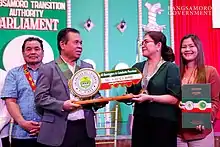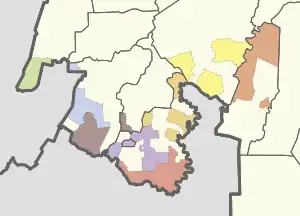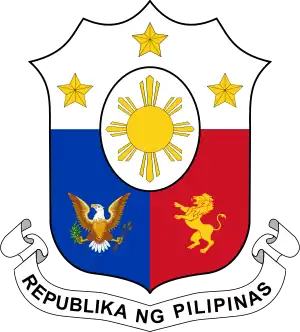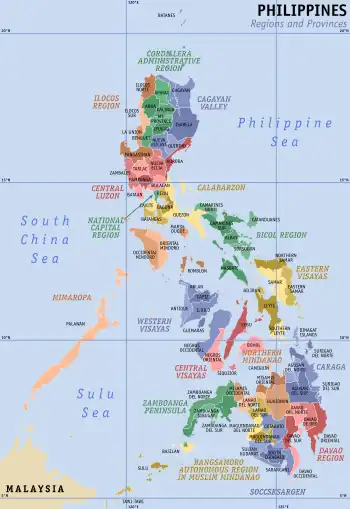Special Geographic Area
The Special Geographic Area (SGA) is a loose collection of 63 barangays in six municipalities of the province of Cotabato in the Philippines. It is part of the Bangsamoro Autonomous Region in Muslim Mindanao, despite the province of Cotabato itself being part of a separate neighboring region, Soccsksargen.
Special Geographic Area | |
|---|---|
.svg.png.webp) Territory in Cotabato province under the special geographic area of Bangsamoro | |
| Country | |
| Region | |
| Province | Cotabato (geographically only) |
| Municipalities | (geographically only) |
| Area clusters | 8 |
| Barangays | 63 |
| Plebiscite of Cotabato barangays to join Bangsamoro | February 6, 2019 |
| Turnover to Bangsamoro | November 20, 2019 |
| Government | |
| • Body | Special Geographic Area Development Authority[1] |
| • Administrator | Mohammad Kelie Antao |
| Area | |
| • Total | 824.311 km2 (318.268 sq mi) |
| Population (2020 census)[2] | |
| • Total | 215,433 |
| • Density | 260/km2 (680/sq mi) |
These barangays were partitioned from Soccsksargen following a two-part plebiscite held in January and February 2019 that formed Bangsamoro after residents of said barangays consented to their localities' inclusion in the new autonomous region. The municipalities these barangays are a part of, as well as the barangays themselves, remain part of Cotabato. These barangays could be reorganized into one or more new municipalities or merged with any of the neighboring municipalities in Maguindanao del Norte and Maguindanao del Sur, which are part of Bangsamoro.
The Bangsamoro regional government has started effective governance over these barangays since the official turnover of these localities to the region by the Cotabato provincial government on November 20, 2019.
Some of these barangays are exclaves, which means they are entirely surrounded by localities that are not part of Bangsamoro.
History

The Philippine government organized a two-part plebiscite that concerns the ratification of the Bangsamoro Organic Law, the founding basis of the then-to-be established Bangsamoro Autonomous Region in Muslim Mindanao (BARMM), which was intended to replace the Autonomous Region in Muslim Mindanao (ARMM), and the expansion of the then-proposed Bangsamoro autonomous region to potentially include municipalities in Lanao del Norte, the cities of Isabela in Basilan and Cotabato in Maguindanao, and select barangays in Cotabato province. For the prospective barangays in Cotabato to join, voters in all of the parent municipalities also had to consent to their bid to join Bangsamoro.
Out of 67 barangays in Cotabato that were included in the plebiscite, 63 had successful bids for their inclusion in the Bangsamoro autonomous region.[3] The four that rejected the measure are Galidan in Tulunan, Balatican in Pikit, and Pagangan and Lower Mingading in Aleosan; these four were excluded from BARMM and remained part of Soccsksargen. Meanwhile, each municipality consented to its barangays joining the BARMM. In Pikit, the most populous municipality in Cotabato, all but one barangay that voted in the plebiscite to join declined. This led to 20 barangays staying out of the BARMM out of 42. Pikit's town hall, which is located in Fort Pikit, one of the barangays that voted for inclusion, is being petitioned to be annexed by Poblacion, one of the towns that did not petition to be included.[4]
The barangays in Aleosan and Tulunan voted in favor of their inclusion, but the majority of voters in the rest of their parent municipalities voted against the barangays' inclusion. Barangay Baltican in Pikit rejected their inclusion, while the rest of Pikit consented to the barangay's inclusion and would have been part of the new autonomous region if Baltican voters also voted for their inclusion.[5]
Upon the effective foundation of the new Bangsamoro autonomous region, the barangays remained part of their parent municipalities. Their residents voted for municipal officials of their parent municipalities and Cotabato provincial officials in the 2019 Philippine general election.[6] The barangays could be reorganized into one or more municipalities or merged with any of the neighboring municipalities in Maguindanao.[7]
The full transfer of jurisdiction of the Cotabato barangays to the Bangsamoro autonomous government was ordered by Secretary of the Interior and Local Government Eduardo Año following a meeting with Bangsamoro Chief Minister Murad Ebrahim on July 8, 2019.[8]
These barangays were still not under the effective control of Bangsamoro as of July 2019 since they were not yet officially turned over to the Bangsamoro regional government, which was initially set to occur once a local government code was passed by the Bangsamoro Parliament.[9]
With the local government code still pending, the official turnover took place on November 20, 2019.[10][11] The Sangguniang Panlalawigan of Cotabato has passed a resolution concerning the transfer. Amidst budgetary concerns, the barangays were assured that they will still receive their internal revenue allocation directly from the Department of Budget and Management after the transfer takes place.[12]

By March 2020, the 63 barangays had already been grouped into a special geographic area of the Bangsamoro region.[13]
Chief Minister Murad Ebrahim issued an executive order establishing a Development Coordinating Office (DCO) led by an administrator and eight area coordinators to manage affairs in the 63 barangays in Cotabato. Mohammad Kelie Antao was appointed administrator on June 30, 2020. Jimmy Adil, Jabib Guiabar, Esmael Maguid, Duma Mascud, Ibrahim Rahman, Abdulatip Tiago, and Nayang Timan were appointed as area coordinators on the same date.[14]
A second ceremony was held on December 15, 2020, to mark the symbolic assumption of the Bangsamoro regional government over the 63 Cotabato barangays along with Cotabato City.[15]
On August 17, 2023, the bills consolidating the barangays into 8 municipalities were approved by the Bangsamoro Parliament,[16] a signature of the Chief Minister and plebiscites in the barangays are still pending.
Governance
The special geographic area of Bangsamoro consists of barangays that are part of Cotabato province, which is not part of the autonomous region, despite the barangays themselves being part of Bangsamoro. For the Bangsamoro region to govern the barangays, these were constituted into a single administrative area under the direct supervision of the Bangsamoro chief minister through the region's Ministry of the Interior and Local Government (MILG). The MILG deals with the affairs of the area through the Special Geographic Area Development Authority, which is headed by an administrator appointed by the chief minister.[1]
Subdivisions
Area clusters

The 63 barangays in the special geographic area of Bangsamoro is grouped into eight area clusters.[17] Each barangay consists of puroks while some have sitios.
| Cluster | Population (2020)[18] |
|---|---|
| Carmen | 28,463 |
| Kabacan | 16,658 |
| Midsayap I | 25,573 |
| Midsayap II | 22,438 |
| Pigcawayan | 19,627 |
| Pikit I | 38,795 |
| Pikit II | 34,341 |
| Pikit III | 29,538 |
| Total: Eight clusters | 215,433 |
List of barangays
| Barangay | Municipality | Cluster | Population (2020) [2] |
|---|---|---|---|
| Balacayon | Pigcawayan | Pigcawayan | 1,306 |
| Bago-inged | Pikit | Pikit II | 3,080 |
| Barungis | Pikit | Pikit II | 3,367 |
| Batulawan | Pikit | Pikit I | 6,306 |
| Bualan | Pikit | Pikit III | 2,177 |
| Buliok | Pikit | Pikit II | 4,624 |
| Bulol | Pikit | Pikit II | 5,145 |
| Buluan | Kabacan | Kabacan | 1,418 |
| Buricain | Pigcawayan | Pigcawayan | 1,626 |
| Central Labas | Midsayap | Midsayap I | 1997 |
| Damatulan | Midsayap | Midsayap II | 4,570 |
| Datu Binasing | Pigcawayan | Pigcawayan | 1,650 |
| Datu Mantil | Pigcawayan | Pigcawayan | 1,220 |
| Dunguan | Aleosan | Pikit III | 3,285 |
| Fort Pikit | Pikit | Pikit I | 7,476 |
| Gli-Gli | Pikit | Pikit II | 3,861 |
| Gokotan | Pikit | Pikit I | 5,494 |
| Kabalasan | Pikit | Pikit II | 7,591 |
| Kadigasan | Midsayap | Midsayap II | 5,441 |
| Kadingilan | Midsayap | Midsayap II | 2,414 |
| Kadingilan | Pigcawayan | Pigcawayan | 1,683 |
| Kapinpilin | Midsayap | Midsayap I | 4,593 |
| Kibayao | Carmen | Carmen | 7,146 |
| Kitulaan | Carmen | Carmen | 6,079 |
| Kudangaran | Midsayap | Midsayap II | 3,218 |
| Lagunde | Pikit | Pikit III | 5,332 |
| Langogan | Carmen | Carmen | 2,082 |
| Libungan Torreta | Pigcawayan | Pigcawayan | 2,290 |
| Lower Baguer | Pigcawayan | Pigcawayan | 1,208 |
| Lower Pangangkalan | Pigcawayan | Pigcawayan | 1,129 |
| Macabual | Pikit | Pikit II | 4,557 |
| Macasendeg | Pikit | Pikit III | 2,516 |
| Malingao | Midsayap | Midsayap I | 4,456 |
| Manaulanan | Pikit | Pikit III | 7,632 |
| Manarapan | Carmen | Carmen | 4,355 |
| Matilac | Pigcawayan | Pigcawayan | 1,817 |
| Mudseng | Midsayap | Midsayap I | 2,831 |
| Nabalawag | Midsayap | Midsayap II | 3,093 |
| Nabundas | Pikit | Pikit I | 4,996 |
| Nalapaan | Pikit | Pikit I | 2,323 |
| Nanga-an | Kabacan | Kabacan | 3,715 |
| Nunguan | Pikit | Pikit I | 5,380 |
| Nasapian | Carmen | Carmen | 4,423 |
| Olandang | Midsayap | Midsayap II | 3,702 |
| Panicupan | Pikit | Pikit I | 2,357 |
| Patot | Pigcawayan | Pigcawayan | 2,287 |
| Pebpoluan | Carmen | Carmen | 1,038 |
| Pedtad | Kabacan | Kabacan | 4,593 |
| Pamalian | Pikit | Pikit III | 3,256 |
| Rajah Muda | Pikit | Pikit II | 2,116 |
| S. Balong | Pikit | Pikit III | 3,573 |
| S. Balongis | Pikit | Pikit I | 4,463 |
| Sambulawan | Midsayap | Midsayap I | 3,599 |
| Sanggadong | Kabacan | Kabacan | 869 |
| Simbuhay | Kabacan | Kabacan | 1,871 |
| Simone | Kabacan | Kabacan | 2,652 |
| Simsiman | Pigcawayan | Pigcawayan | 2,506 |
| Tamped | Kabacan | Kabacan | 1,540 |
| Tapodoc | Aleosan | Pikit III | 1,767 |
| Tugal | Midsayap | Midsayap I | 4,665 |
| Tumbras | Midsayap | Midsayap I | 3,432 |
| Tupig | Carmen | Carmen | 3,340 |
| Upper Pangankalan | Pigcawayan | Pigcawayan | 905 |
| Total population | 215,433 | ||
Reorganization
In September 2019, there was a reported proposal to reorganize the Cotabato barangays into four municipalities through regional legislation and possibly annex them to the neighboring Maguindanao province. Pending the passage of the regional law, there is a plan by Chief Minister Murad Ebrahim to issue an executive order to group the barangays into eight clusters.[20] However, such a plan to form towns from the barangays was temporarily set aside, and it was decided that an administrative body be formed to oversee the barangays' affairs.[21]
Another proposal was to group the barangays into three municipalities instead of four. One of the proposed municipalities is Sultan Tambilawan, which is planned to consist of Midsayap's 13 barangays.[22]
The regional government will wait for the results of the 2020 census to determine the exact barangays that will be reorganized into new towns.[23]
On December 21, 2022, a proposal was made to group the barangays into eight municipalities.[24][25] The proposed municipalities are Pahamudin, Kadayangan, Nabalawag, Old Kaabakan, Kapalawan, Malidegao, Tugunan, and Ligawasan, which are created by the virtue of various Bangsamoro Autonomy Acts.
| Municipality[lower-alpha 1] (Other proposed name/s) | Barangays | Bangsamoro Autonomy Act No. |  Proposed municipalities that will be created from the special geographic area of Bangsamoro: Pahamudin
Kadayangan
Nabalawag
Old Kaabakan
Kapalawan
Malidegao
Tugunan
Ligawasan | |
|---|---|---|---|---|
| Seat of government | Other barangays | |||
| Pahamudin | Libungan Torreta |
| 41 | |
| Kadayangan | Kapinpilan |
| 42 | |
| Nabalawag (Kabalukan) | Nabalawag |
| 43 | |
| Old Kaabakan (Northern Kabacan / Laya[27]) | Nangaan |
| 44 | |
| Kapalawan | Manarapan |
| 45 | |
| Malidegao (Malmar or Madridagao[27]) | Fort Pikit |
| 46 | |
| Tugunan | Manaulanan |
| 47 | |
| Ligawasan | Bagoinged |
| 48 | |
Notes
- Names as stated in the final approved bills;[26] other proposed names in parentheses
References
- "Bangsamoro Autonomy Act No. 13". Bangsamoro Parliament. Retrieved November 7, 2020.
- Census of Population (2020). "Region XII (Soccsksargen)". Total Population by Province, City, Municipality and Barangay. Philippine Statistics Authority. Retrieved July 8, 2021.
- Santos, Tina (February 15, 2019). "63 Cotabato barangays now part of BARMM". Philippine Daily Inquirer. Retrieved May 22, 2019.
- Arguillas, Carolyn O. "Pikit's fate: 20 barangays remain with Cotabato, 22 joining BARMM". MindaNews. Retrieved February 10, 2019.
- Depasupil, William (February 15, 2019). "63 NCotabato villages to join Bangsamoro". The Manila Times. Retrieved February 18, 2019.
- Arguilas, Carolyn (February 8, 2019). "Pikit's fate: 20 barangays remain with North Cotabato, 22 joining BARMM". MindaNews. Retrieved February 9, 2019.
- Layug, Margaret Claire (February 8, 2019). "What happens to Cotabato barangays not part of new Bangsamoro region?". GMA News (in English and Tagalog). Retrieved May 22, 2019.
- Fernandez, Edwin (July 9, 2019). "Cotabato City, 63 villages placed under BARMM". Philippine News Agency. Retrieved July 9, 2019.
- Fernandez, Edwin (July 21, 2019). "NoCot guv, BARMM chief meet on fate of 63 villages". Philippine News Agency. Retrieved July 22, 2019.
- Macabalang, Ali (November 13, 2019). "BARMM to assume official supervision over 63 NorCot villages on Nov. 20". Manila Bulletin. Retrieved November 13, 2019.
- Cabrera, Ferdinandh (November 20, 2019). "63 North Cotabato villages officially now part of BARMM". NDBC News. Archived from the original on December 11, 2019. Retrieved April 19, 2020.
- Cayon, Manuel (November 15, 2019). "North Cotabato's 63 barangays to be turned over to Barmm". BusinessMirror. Retrieved November 15, 2019.
- Fernandez, Edwin (March 21, 2020). "BARMM records 2 Covid-19 deaths, 2 infected". Retrieved June 30, 2020.
- "BARMM creates office to administer 63 barangays in North Cotabato". BARMM Bureau of Public Information. June 30, 2020. Retrieved June 30, 2020.
- Unson, John (December 18, 2020). "North Cotabato promises support for 63 villages now in BARMM". The Philippine Star. Retrieved January 1, 2021.
- "BARMM approves creation of 8 new towns". Manila Bulletin. Retrieved August 19, 2023.
- Fuerzas, Edgar (June 29, 2020). "Administrador sa mga barangay sa Barmm napili na" [The administrator of barangays in Barmm has been elected]. Superbalita Davao. SunStar (in Cebuano).
- Total Population, Household Population, Number of Households, and Average Household Size by Region, Province, and City/Municipality: Philippines, 2020. Philippine Statistics Authority.
- "PSA Board Resolution No. 13, Series of 2021: Approving and Adopting the Third Quarter 2021 Philippine Standard Geographic Code Updates to Include the Bangsamoro Autonomous Region in Muslim Mindanao (Barmm) and Correct the Names of 37 Barangays" (PDF). Philippine Statistics Authority. 2021. Retrieved April 1, 2022.
- Macabalang, Ali (September 10, 2019). "63 brgys which voted to join BARMM to comprise 4 clustered municipalities". Manila Bulletin. Retrieved September 10, 2019.
- Fernandez, Edwin (September 19, 2019). "BARMM shelves cluster plan for 63 NoCot villages". Philippine News Agency. Retrieved September 20, 2019.
- Fuerzas, Garry (September 23, 2019). "Konsultasyon patuloy sa 63 brgys sa North Cotabato na sinakop ng BARMM" [Consultation continues with 63 barangays in North Cotabato absorbed by BARMM]. Bombo Radyo Philippines (in Tagalog). Retrieved September 24, 2019.
- Solaiman, Taher (November 23, 2019). "Cotabato cedes 63 villages to Bangsamoro". Philippine Daily Inquirer. Retrieved November 23, 2019.
- Sahidala, Johaira (December 21, 2022). "Gov't of the Day files bills creating 8 municipalities in BARMM Special Geographic Area". Bangsamoro Information Office. Retrieved December 21, 2022.
- Cabrera, Ferdinandh (December 22, 2022). "Bills seek creation of eight municipalities in BARMM's Special Geographic Area". MindaNews. Retrieved December 22, 2022.
- "Bills creating 8 municipalities in SGA-BARMM approved by BTA Parliament". Luwaran. August 20, 2023. Retrieved August 25, 2023.
- "Constituents unite in support of establishing municipalities in BARMM Special Geographic Area". Bangsamoro Parliament. June 11, 2023. Retrieved June 13, 2023.


